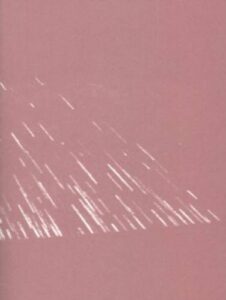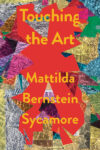[Roma Publications; 2016]

Bart Lodewijks’ process:
w/ a spirit level for a straight edge Lodewijks makes lines w/ chalk on buildings, walls, stones, walkways, roads, trees, “galvanized metal sheets — they’re the perfect surface for chalk drawings,” rusted cast iron, & interior walls. He makes his lines in “urban neighborhoods” over an extended period (years). Once done with a drawing, he documents it with photographs (“foto-reportage”). While he works, he is exposed to the public & welcomes “social intercourse.” Praise, advice, criticism (“I haven’t seen anything artistic in [your drawings]”; “There’s no one stopping you from using coloured chalk”), chit-chat, invitations to tea & meals, & local history lessons (“Cathyanne told me that in the first half of the previous century her father went to Rosses Point to collect coal. As he was pushing his cart across the beach he notices a long thin thing in the sand. It was a Viking sword”). His lines “relate” to the surfaces he marks (except when they don’t: “Free-floating lines work as an incentive to return to the place . . . ).
The drawings are in & of themselves appealing artworks, but the drawings are only a component of a greater project.
I’m reminded of the breaching experiments we read about in sociology class. Stand in an elevator w/ your back to the door & record how people react, etc.
People attempt to explain Lodewijks’ behavior so it fits w/ their expectations — “I thought you were a surveyor” &,
‘But what does the drawing stand for?’ the woman in the flower-patterned coat comes and asks me. I don’t answer. ‘It looks like a sort of ship’s prow, a ship that’s sinking in the rain’ she guesses. ‘How do you know that? That’s exactly what it is.’ ‘Nobody takes the mickey out of me,’ she says and proudly goes on her way.
I’m reminded of Andy Goldsworthy’s sculpture, although his work is not about people.
Leigh, resident of the Garavogue Villas, is reminded of his music collection:
‘They’re mainly minimal music,’ he tells me, and then he goes on to say, ‘I’m very keen on it but my friends don’t share my taste. With them I talk about football. They think my music is boring. The music’s good because it’s purely about music, just like your drawings are themselves and don’t claim to allude to anything outside themselves.’
From my own music collection, the artwork for Autechre’s ep 7 & Vladislav Delay’s Multila is reminiscent of Lodewijks’ drawings. Leigh sees Lodewijks as a kindred spirit; Lodewijks considers Leigh’s remarks worth recording. I’m not sure I understand what Lodewijks means when he says (in an interview for The Word), “The highest goal, for me, is to bring to light the daily dynamic of places and situations as something many can recognize themselves in,” but Leigh recognizes himself in what Lodewijks draws.
Uncharacteristically, Lodewijks teases a woman who doesn’t believe he has the authority to draw where he’s drawing; she’s easily flummoxed and he can’t resist:
‘You’re not allowed to write on the wall,’ she says fiercely. ‘You know that perfectly well, don’t you?’ ‘What’s your name?’ I ask. ‘Agata,’ she says. ‘A-G-A-T-A,’ I slowly spell her name out loud when I write it on the wall.
Otherwise, he doesn’t make fun of the people he interacts w/, who, in spite of their foibles — be it Pat who “appears, wearing nothing but boxer shorts and slippers” or Peggy whose house & garden is a “paradise of dwarfs” & fairy tale figurines — , invariably come across as charming & decent folk.
& — Agata aside — folk who respond supportively & creatively to Lodewijks’ impractical project. Lodewijks says, “The drawings aren’t seen as art by these people” — but that’s not true. Leigh recognizes Lodewijks as an artist. Lily “offers [her] whole house to draw in” & when Lodewijks finishes she “examines it closely” & declares, “From now on it belongs here officially.” & though attempts to interpret Lodewijks’ drawings are naïve — a sinking ship, “a house for elephants,” “a bird flying overhead” — those attempts signal a belief that his abstract lines are more than decoration.
I don’t find this surprising at all. When art is shared w/out condescension, people tend to respond with interest.
I attempted my own Lodewijks imitation on the walkway & steps in front of my house. In lieu of a spirit level, I used a yard stick. Lodewijks doesn’t identify the brand of chalk he favors; I used Crayola sidewalk chalk — a nice, big piece of it. To make solid, bright lines on the pebbly concrete required me to press down firmly & to go over lines repeatedly. I made two gradually diverging lines about ten feet long. I spent a half hour on my knees. No small effort. When my wife saw my lines she tried her hand at making her own; then my youngest, too — we started to explain the process to her but she dismissed us. She got it right away.
Adam Golaski is the author of Color Plates and Worse Than Myself. For more visit Little Stories.
This post may contain affiliate links.







